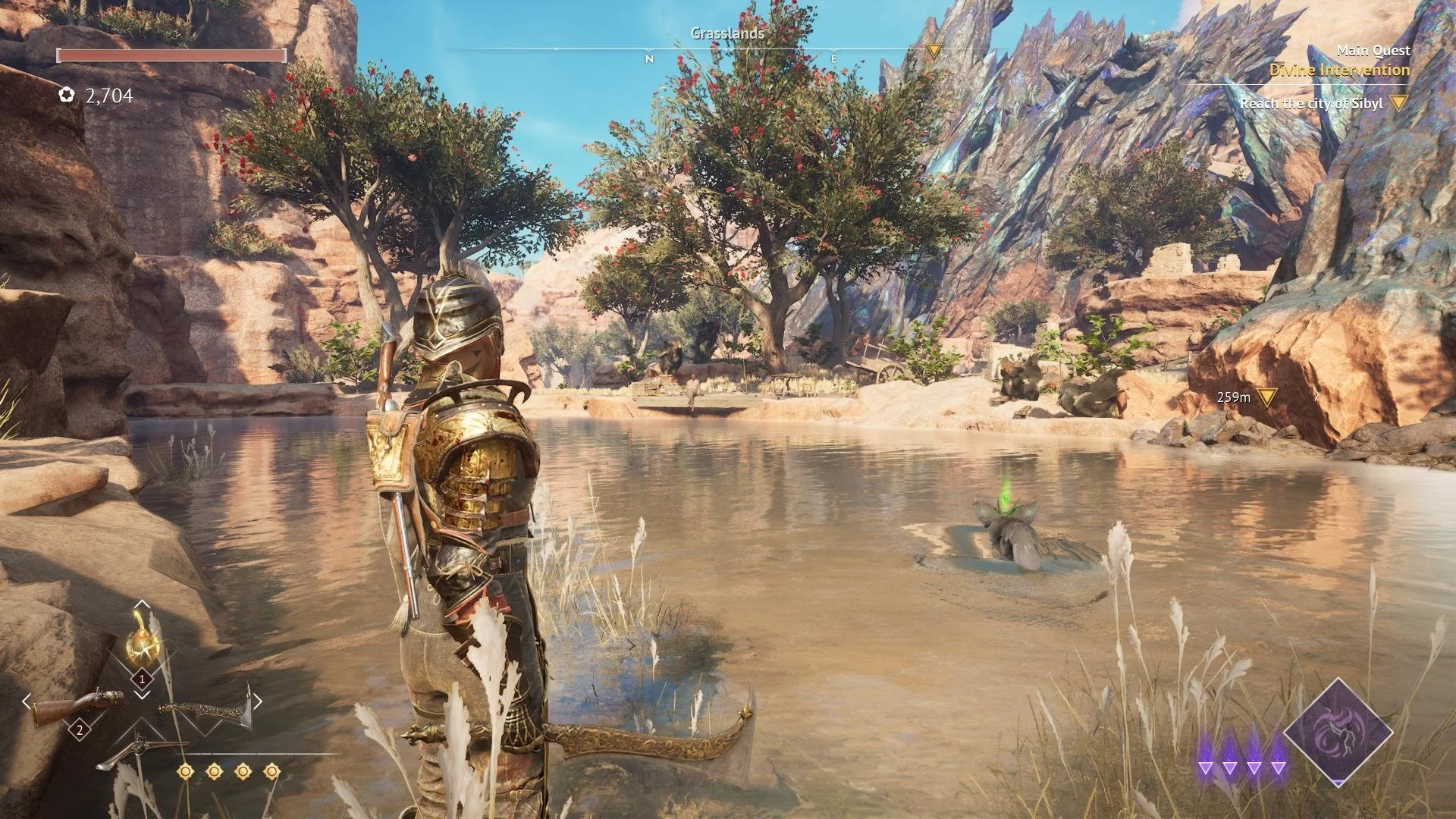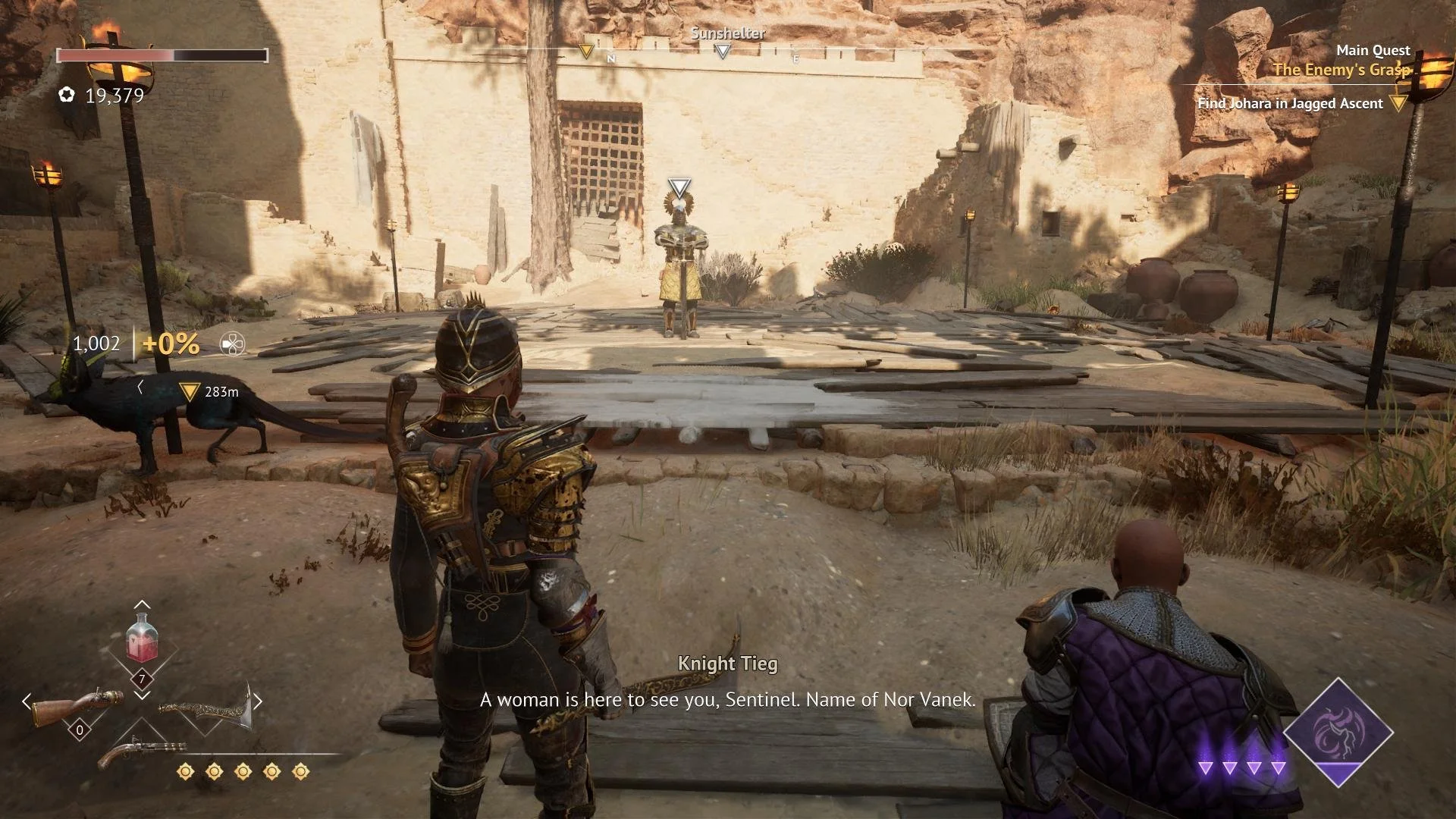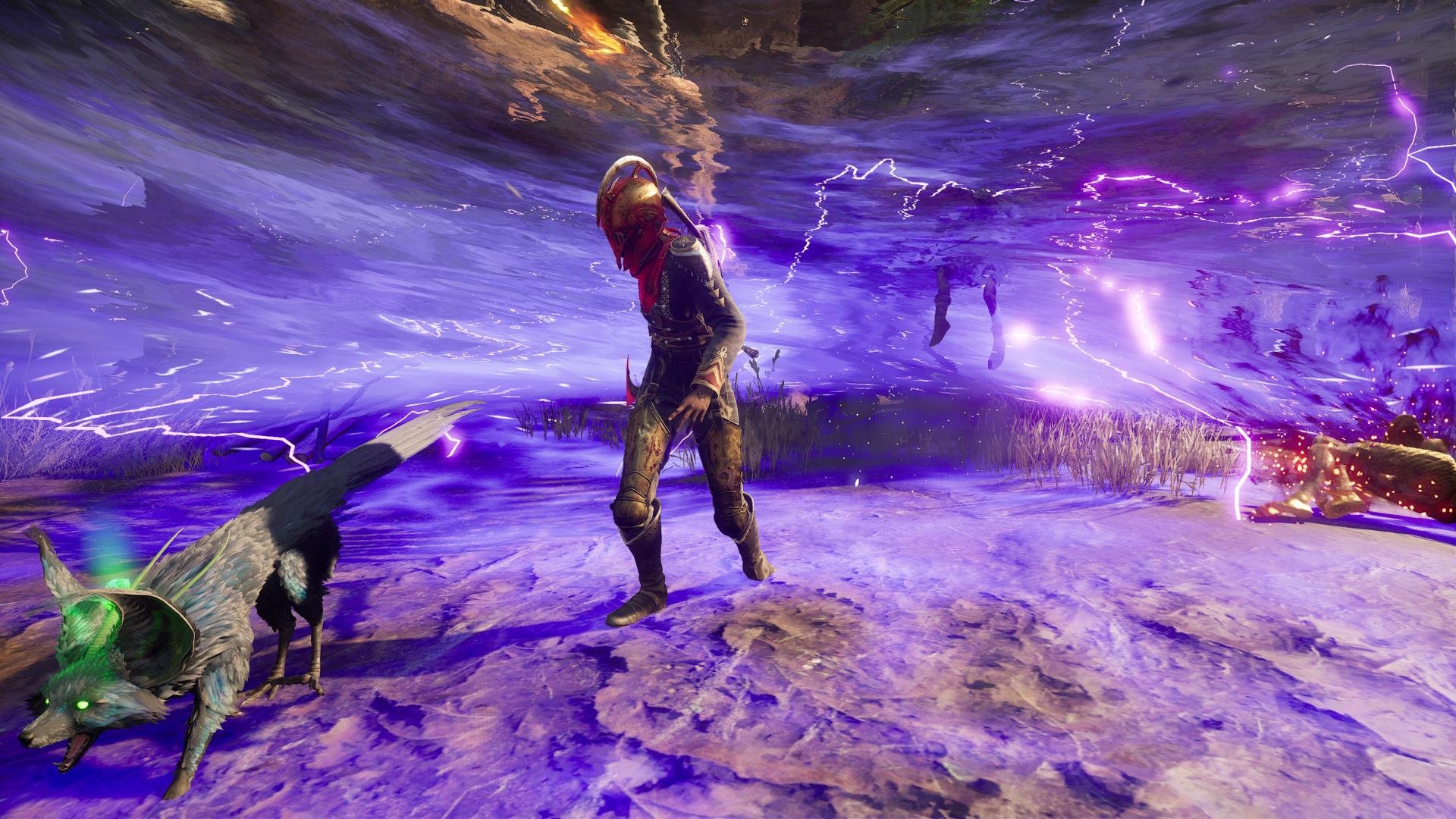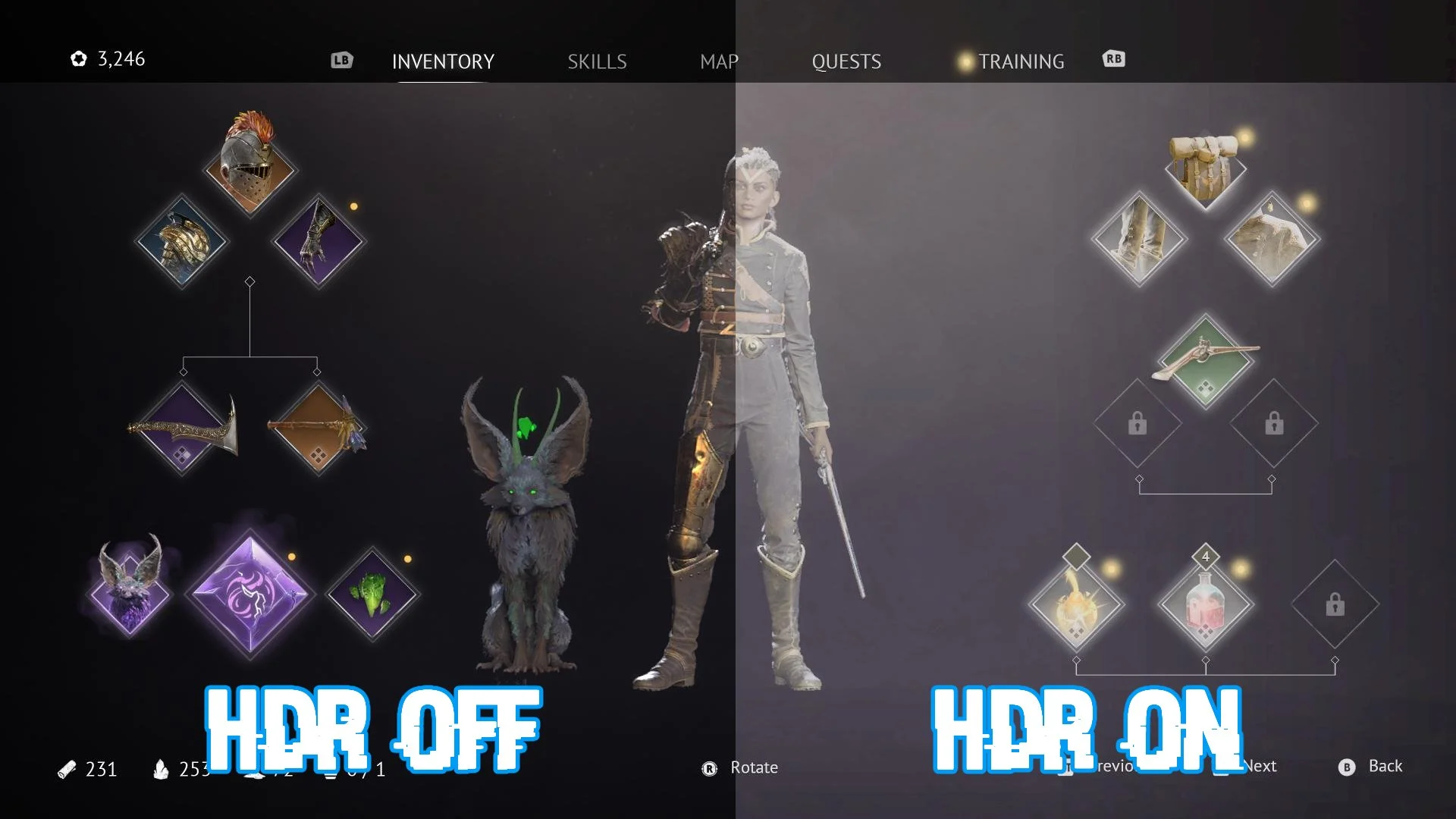“You’re a sapper first, remember?”
Flintlock: The Siege of Dawn appeared to be a game that would check many boxes for me. Every trailer that was shown off only looked to further my desire to play it. After completing every quest, and exploring nearly every pixel the game offered, I found the overall experience to not live up to what I personally wanted from it. It’s by no means a bad game, but one that misses in a few places that could have turned it around to be something truly fantastic.
Since it was first shown off, Flintlock has been described as being something of a “Soulslite”, a tamer adaption of the soulslike formula than what we’ve seen flooding the market from every developer under the sun. While certain aspects of that formula are present, I don’t believe it truly gives itself to the criteria many use to compare it to the genre. Can it be difficult? Sure. Are there your typical bonfires and respawning enemies? Sort of. Shortcuts to get you back to previous places? Not in that sense, no. If anything, this feels more like a limited focus on the character action game, especially as it has a combat-multiplier ala Devil May Cry to keep you active in combat. Regardless of the label you place on it, fans of each of those genres still may find something to like, or dislike about the whole package that is presented here.
Flintlock: The Siege of Dawn follows the journey of Nor Vanek, an experienced soldier called a Sapper. She is remarkably skilled and one tasked with tracking down a contingent of her forces as they attempt to close the door to a realm called the Great Below. In this world, the dead are threatening the surface as they have risen from their realm, killing thousands as they cause untold destruction. However, as Nor and her allies attempt to seal off this threat, a towering god easily stops their crusade, causing Nor to be separated from her allies and cast well below into the depths.
It is in these depths that she will meet Enki, a small blackish fox-like creature who is the very type of being she is built to kill. However, after granting her some abilities as a gesture of goodwill, and the means to defy his own brethren in the process, Nor and Enki begin a quest to defeat the gods and save the city of Dawn and its people. Just who is Enki and why has he made this pact? Well, the game certainly drags that question out.
The story of Flintlock: The Siege of Dawn is interesting in its ideas, and purpose. All told, it’s an engaging concept. However, the execution and method of telling that story is any but. There are revelations and reveals that pit Nor and Enki almost against one another, arguments that begin, but then only end after off-camera conversations have already happened. Each chapter ends with some big narrative twist between the two, but the off-camera travel time from one place to the other has seen most of that conflict already resolved. It’s a shame because when we get to see some of it, it fleshes out more of these characters and their relationship, making them vastly more interesting as a result. The bond they share in the game’s final moments should mean something, but most of their development was hidden from us.
This also causes the supporting cast to be lacking and cast aside. One of the game’s biggest cast members is Elias Toufexis, known to gamers the world over as Deus Ex’s Adam Jensen. Here, he plays Baz, a mentor of sorts to Nor. While Toufexis is a great “get” here, the audio mixing for him and everyone else is beyond off. Honestly, I could not hear a single word he said clearly and frankly, the story does nothing with him apart from becoming an upgrade shop for Nor when he and the rest of the cast could have been so much more. While you’ll recruit more allies to join your camp, they will have brief moments of dialogue, grant a paltry number of quests, and join Baz in allowing you to upgrade your gear. It’s almost as if the team knew what to do with Nor and Enki but not what to do with anyone else.
Nor is brought to life by Olive Gray. While many will simply look to her as Miranda Keys in Paramounts now-cancelled Halo series, her performance as Nor is quite impressive. Enki is portrayed by Alistair Petrie, a man who you’ll instantly recognize with a quick Google search, and one I have seen in dozens of films. Both actors work well and when given the material to do so, are stellar together. Each brings a past to their performance here, one that allows the characters to shine, even despite the failings of the execution of its story.
This story takes Nor and Enki across a few sizable maps, with the major focus on Three Peaks and Wanderer’s Rest. Each location has collectibles to track down in the form of flags to shoot, as well as several outfits, items, upgrades, and equipment that are scattered across each location. You’ll also have various mini-bosses to fight with settlements to clear out so that their population can return. These spaces then open up to largely be a storefront via a Coffee Shop that can grant side quests as well as new outfits for Nor, even if they are just variations of similar-looking jackets with varying colors. Thankfully, the gauntlets and helmets you track down are infinitely more cool.
While being able to double jump and dash will certainly get you around, you’ll also be able to fly, at least sort of. Enki will point out situational rifts that have formed and grant you the ability to fly between each node. This effect is very cool and honestly, is used well, to a point. As mentioned, this game is described as being a “Soulslite” and frankly, this is one area where it earns that “lite” additive. In traditional Soulsikes, shortcuts are part of the genre in a big way. Unlocking a door to find a previous area was always a cool moment. Kicking down a ladder to find your way back, never lost its charm. However, most of the rifts you’ll open merely have you flying back to previous areas instead of relying on good level design to really make it meaningful. I love the ability to glide through the air and as Nor herself says she’ll never get tired of it, I agree, I never once did. However, it being used to backtrack instead of purposeful level design is a huge miss for me.
I mentioned before that you’ll largely focus on two main areas with a third that is designed around being a very linear focus as you are paced through it rather quickly. The world itself looks great, being a combination of numerous time periods and settings. You’ll start racing through the trenches of a world war to architecture and settings of several time periods that are fantastical in design. This is also the case for many of its enemies. From the undead to spiders to knights clad in armor, to giant creatures out of the Mesopotamia era, the team takes a lot of liberties to convey a merging of numerous assets to make something that generally does flow nicely together. I do wish the enemy variety was a bit more varied as several of the basecamp mini-bosses are typically just the same character, especially in the game’s second main area; I felt I was killing that mini-boss several times over.
The world itself looks great and highly detailed with a lot of gorgeous locales to take in. Texture quality is superb and the general tone and feel of the environments are rather impressive. I will say that the human cast don’t quite fair so well in comparison, showing the limitations of the studio when it comes to modeling its cast. While there is a stylized tone to its people, they don’t reach the same highs as the monsters, creatures, and world around them. Thankfully, Nor can wear a helmet the entire time, so it can prevent some of that from being too in your face too often.
Combat follows several notes of what we have seen before. Nor is equipped with a melee weapon and her ranged flintlock pistol. You’ll be able to gather different weapons, but they don’t change the dynamic too much. Ranged-wise, you can track down and equip muskets, handheld mortars, pistols, a blunderbuss, and cannons to outfit your arsenal. These generally work well with having to rely on a black powder charge that is earned as you deal melee damage. Melee relies on your axe, various blades, and hammers, and that is about it. The axe and blade generally play similarly with the hammer being used to break down the armor of your more formidable foes.
Combat does feel a tad simple due to only having one button for it, despite being able to eventually hold it down to charge up a heavy swing. You can stun enemies to break their stance, parry their attacks, or dodge out of the way, giving you distance to pull out your rifle, and hope you have the time to pull off the reload mini-game, or rely on your Withering, a special attack you perform with Enki, such as a magical storm that damages your enemies to firing off a beam of magical energy.
You can also rely on Enki to inflict a series of curses on them such as poison, ruin, or weakness, each able to be applied by simply tapping the Y button. Being able to have Enki act on their own, or dismantle armored foes, or even transferring all curses to nearby enemies once the marked enemy has been vanquished, allows Enki to feel more than just a simple companion and that they feel like part of the combat system. This deepens as you unlock more abilities through a pretty decent skill tree. The skill tree is split between Powder, Magic, or Steel, which compliments each avenue of the combat system.
One of the biggest issues I have with the combat system is that while you can quickly swap guns during combat, you cannot do so with your melee options. You have to be practically still to pull this off, meaning you cannot perform combo attacks as you switch between your arsenal. Most attack animations cannot even be cancelled to pull off certain abilities, locking you into taking damage for the brief second it takes to then pull off a dodge or parry. It makes combat feel stiff despite how fluid the act of actually performing it is.
During combat, you’ll build up reputation, which is the overall currency you’ll use to procure new outfits, upgrade your weapons, and so on. Reputation is rewarded for combat and if you keep a flawless streak going, meaning you do not take any sort of damage, it will build with a multiplier. However, if you take damage, you’ll only get the base rate. Now, as mentioned, you can often take damage due to not having agency over your animations and not being able to swap weapons quickly can cause a break in your flow. This system is generally a solid idea, pulling from the likes of Devil May Cry with its rating system, but a sequel needs to see a more fluid nature of weapon swaps and animation cancels to really have this system succeed in the ways it feels designed to.
Outside of combat and general exploration, you have Sebo. This is a game played with coins. You’ll find coins in various places, mostly wells, and use those special coins and their unique abilities to form a triangle on a board with connecting nodes. One round is you attacking, the other defending. Some boards are designed for certain coins, so you’ll need to revisit them should they seem impossible from the onset. However, despite the few rounds I did for the sake of trying to learn the game, I never once touched it after, despite having like 8 coins or so by the time I had was nearly done the game. I just didn’t find it even remotely interesting and kept it at a distance.
My initial few hours with the game was met with visuals that were too dark to see with a washed out series of menus. This was the result of the HDR being completely broken on Xbox Series X. Turning off HDR and restarting the game fixed it, but this is one of the first games I have ever seen broken like that at release. I had a few crashes and some occasional glitches, but after disabling HDR, I was able to play through the game with little to no issue.
Flintlock: The Siege of Dawn has some interesting ideas, decent combat, and gorgeous visuals. However, I don’t know if it does enough to really stand out. The story is interesting but is not conveyed well enough to give the cast their due. Combat can feel very simple in the early hours, but does sharpen up to be pretty damn good when you start adding more options. A44 Games is clearly shaping up to create a follow-up and I hope it deepens the combat system, adds more weapon variety, and a way to perform weapon-centric combo attacks between your equipped arsenal. The tools are there to create something truly inspiring, instead of being a greatest hits of mechanics and ideas we’ve seen hundreds of times before.
Developer - A44 Games. Publisher - Kepler Interactive. Released - July 18th, 2024. Available On - Xbox Series X/S, PS5, PC. Rated - (M) Blood, Violence. Platform Reviewed - Xbox Series X. (HDR Off) Review Access - Flintlock: The Siege of Dawn was downloaded and played via Game Pass Ultimate.


















Jeff is the original founder of Analog Stick Gaming. His favorite games include The Witcher III, the Mass Effect Trilogy, Hi-Fi Rush, Stellar Blade, Hellbade: Senua’s Sacrifice, and the Legend of Heroes series, especially Trails of Cold Steel III & IV.